Step into a world where your living room isn’t just a space, but a canvas waiting for your personal touch. Whether you’re just dipping your toes into the world of interior design or you’re a seasoned decorator, “12 Ways To Color Palettes For Modern Living Rooms” is your guide to unlocking the potential of your space with vibrant, thoughtfully curated hues. This guide is more than just a list; it’s a transformative journey that showcases the power of color to redefine your living environment, offering inspiration and clarity for every decorator.
Creating a living room that exudes style and comfort is a rewarding endeavor, and the right color palette is the cornerstone of this transformation. With our carefully selected techniques, you’ll discover how colors can breathe life into your space, enhance mood, and reflect your unique personality. Expect to gain practical insights that will empower you to confidently experiment with colors and layouts, transforming your home into a modern sanctuary. Let the joy of successful interior design fill your life as you explore these vibrant palette ideas, making your living room a place where you love to live.
Incorporate Neutral Base Tones
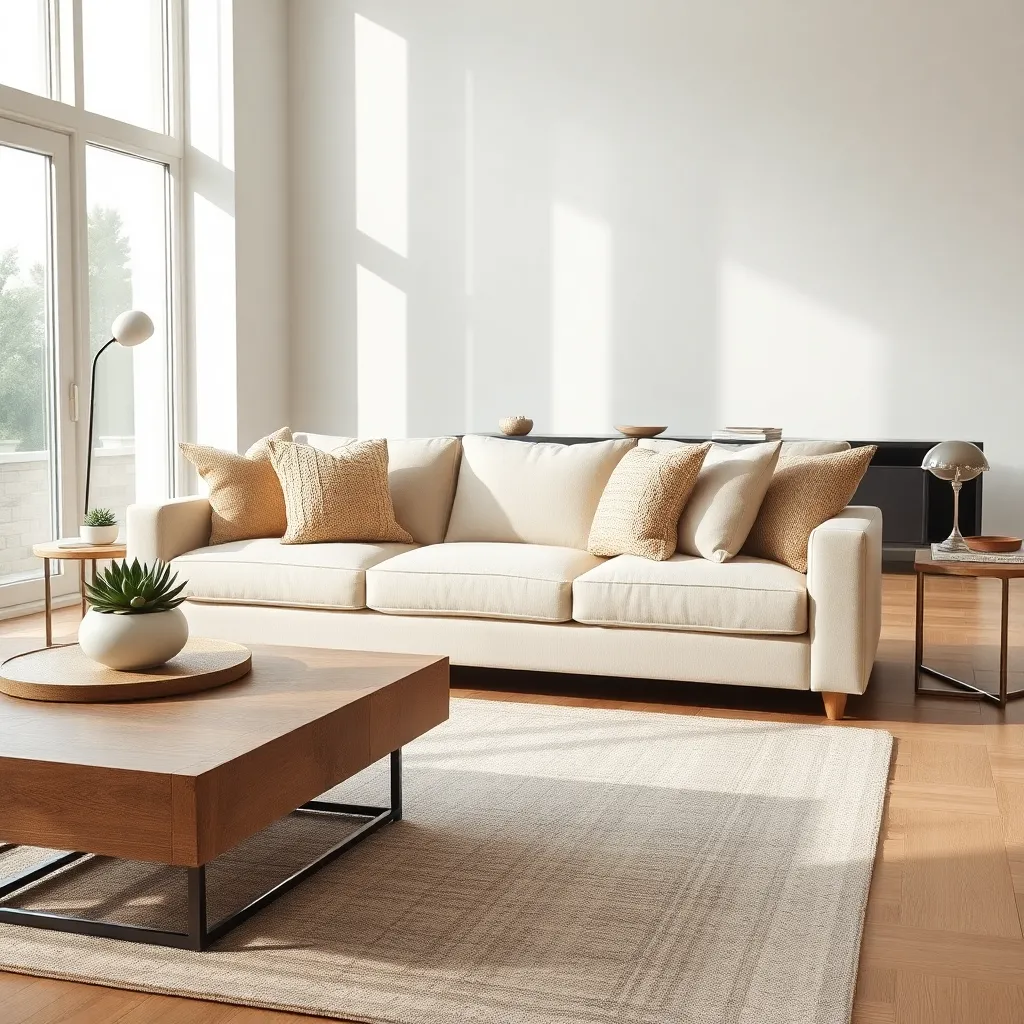
Neutral base tones are the cornerstone of a versatile living room palette, offering a canvas that is both timeless and adaptable. By choosing shades like taupe, beige, or greige for your walls and larger furniture pieces, you create a soothing backdrop that can be easily refreshed with seasonal accents.
To ensure the space remains dynamic, incorporate a variety of textures such as linen, wool, or leather, which add depth and interest to the neutral foundation. Consider using a plush beige sofa paired with a textured wool throw to enhance comfort while maintaining a cohesive look.
Lighting plays a crucial role in accentuating neutral tones, so choose fixtures that provide warm, ambient light to enhance the cozy atmosphere. Opt for a combination of floor lamps and table lamps in complementary materials like brass or wood to maintain visual harmony.
For those looking to add a touch of sophistication, introduce subtle patterns through area rugs or curtains in the same neutral family. This approach allows for visual interest without overwhelming the space, making it ideal for both minimalist and eclectic styles.
Add Bold Accent Colors
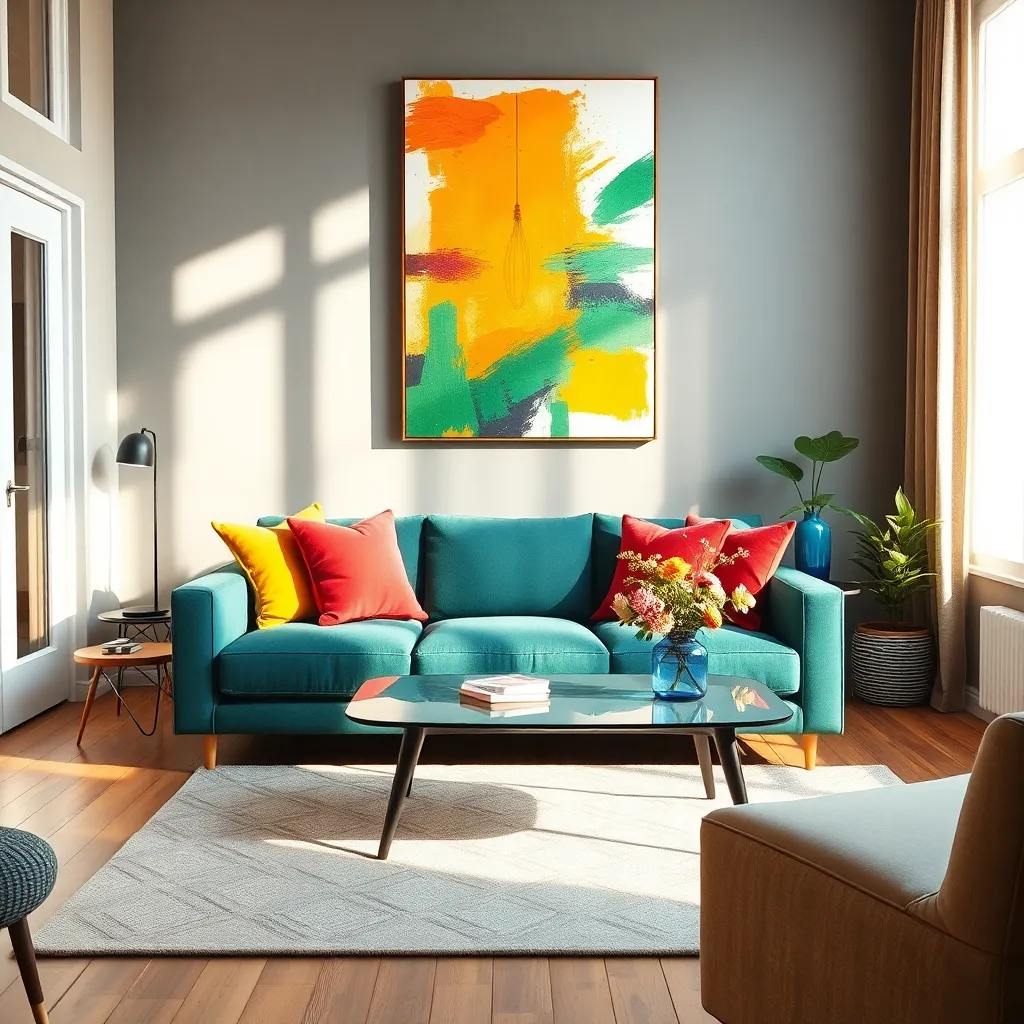
Adding bold accent colors can transform a neutral living space into a vibrant and dynamic environment. Start by selecting one or two bold hues that complement your existing color palette—think deep blues, rich emeralds, or striking reds.
Introduce these colors through accent furniture, such as a vivid armchair or an eye-catching coffee table. Position these pieces strategically to draw attention without overwhelming the space, maintaining a balance with your neutral base tones.
For a more subtle approach, incorporate bold colors through accessories like cushions, throws, and rugs. These elements can be easily swapped out, allowing you to experiment with different shades and patterns until you find the perfect combination.
For those ready to take a bolder step, consider painting an accent wall in your chosen color. This technique creates a focal point in the room and can highlight architectural features or artwork, adding depth and interest to your living space.
Use Complementary Color Schemes

To create a visually striking living room, consider using complementary color schemes, which utilize colors opposite each other on the color wheel, such as blue and orange or purple and yellow. This approach not only adds vibrancy but also maintains a balanced look, making it ideal for both minimalist and eclectic styles.
Begin by selecting a dominant color for your main pieces, such as the sofa or large rugs, ensuring it aligns with your desired mood and style. For instance, a deep navy sofa can be perfectly balanced with burnt orange cushions or a throw, creating a dynamic yet cohesive atmosphere.
Incorporate the secondary color through smaller, strategic accents such as artwork, lamps, or decorative vases, which can be easily swapped out seasonally or when you wish to refresh the space. This method allows you to keep your base decor consistent while still playing with trends or personal tastes.
For those more experienced, layering different shades of the complementary colors can add depth and sophistication. For example, pair light lavender walls with deeper plum curtains and golden yellow accessories to create a rich, layered effect that maintains the room’s energy without overwhelming it.
Layer Shades of One Hue
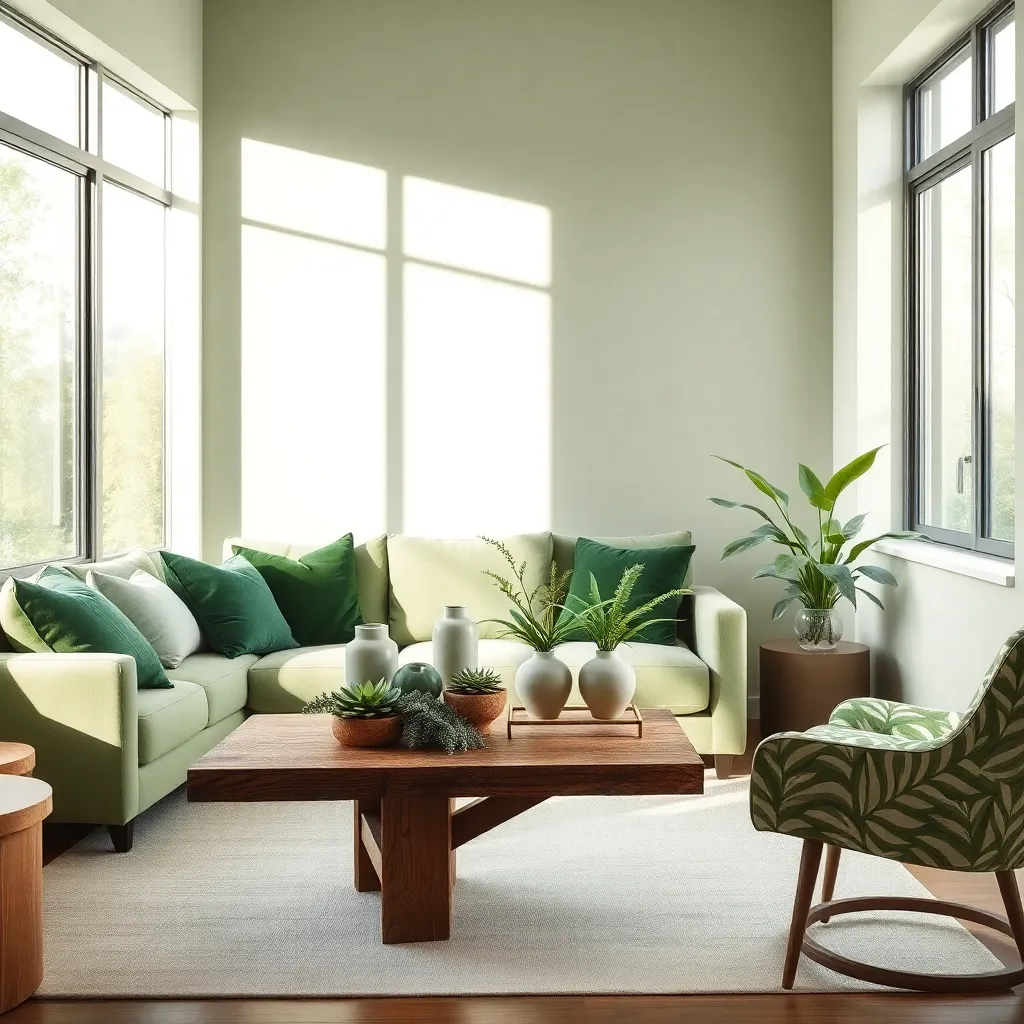
To achieve a sophisticated and cohesive look in your living room, consider layering shades of a single hue. Begin by selecting a base color that resonates with you, such as a calming blue or a warm beige, then incorporate various tones of that color throughout the space to add depth and interest.
Incorporate this technique by using different materials and textures to enhance the layered effect. For example, pair a plush velvet sofa in a deep navy with lighter blue throw pillows and a patterned area rug that incorporates multiple shades of blue.
Avoid monotony by mixing finishes and textures within the same color family. Choose a matte paint for the walls and complement it with gloss-finished accessories, such as vases or picture frames, in the same hue to create visual contrast.
For a more advanced touch, consider using a monochromatic palette to highlight architectural details. Paint trim and molding in a slightly darker or lighter shade than the walls, which can elegantly frame the room and draw the eye to these elements.
Balance Warm and Cool Tones
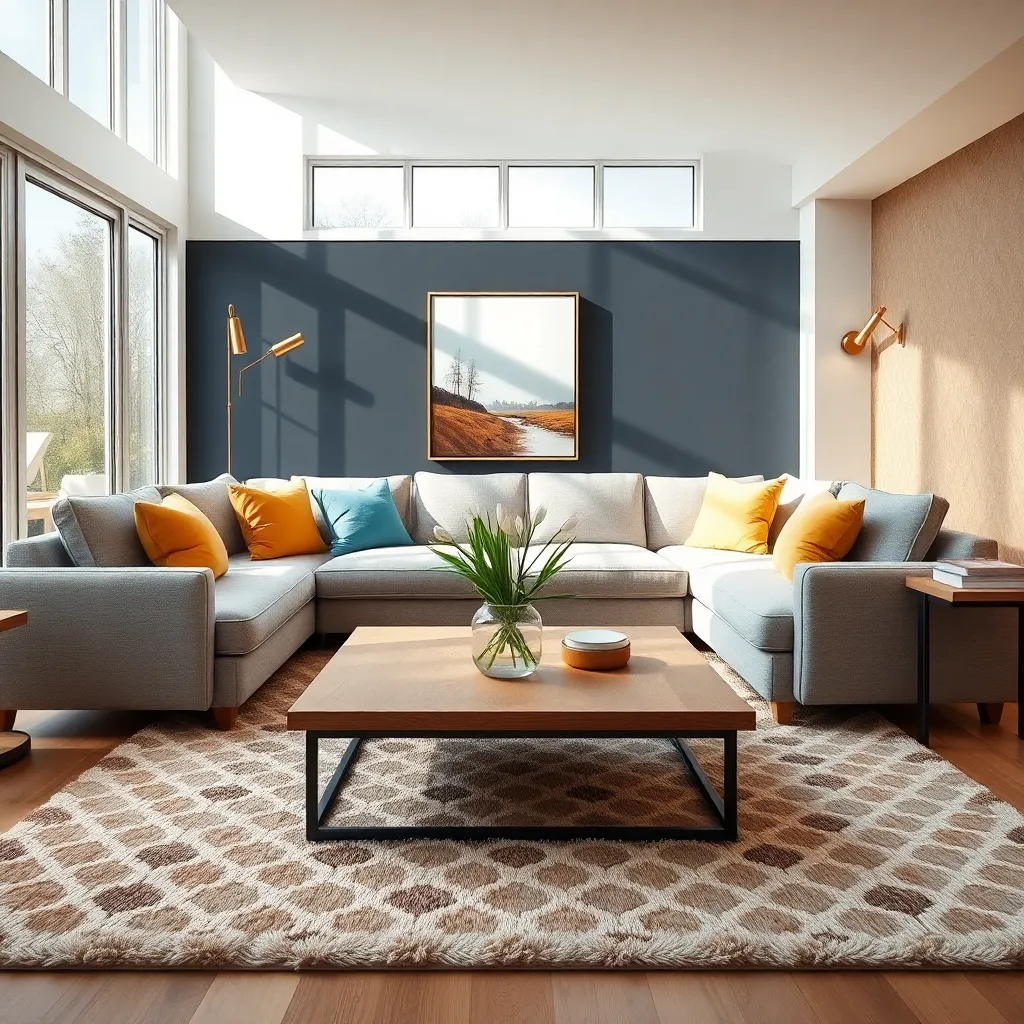
To achieve a harmonious modern living room, it’s crucial to balance warm and cool tones effectively. Start by selecting a dominant color palette that includes one warm and one cool tone, such as pairing a soft beige with a muted blue.
Consider using warm tones like caramel or terracotta for larger furniture pieces like sofas or area rugs. These colors can create a cozy atmosphere, which you can then balance with cool-toned accessories such as steel blue throw pillows or a slate gray coffee table.
Incorporating different textures can help in blending these tones seamlessly. For instance, a woolen throw in a cool tone can be draped over a leather chair in a warm tone, adding both visual and tactile interest.
For advanced decorators, experiment with more daring combinations by incorporating accents of vibrant colors. A mustard yellow vase or an emerald green artwork can further enhance the balanced look and serve as conversation starters.
Introduce Textured Color Elements
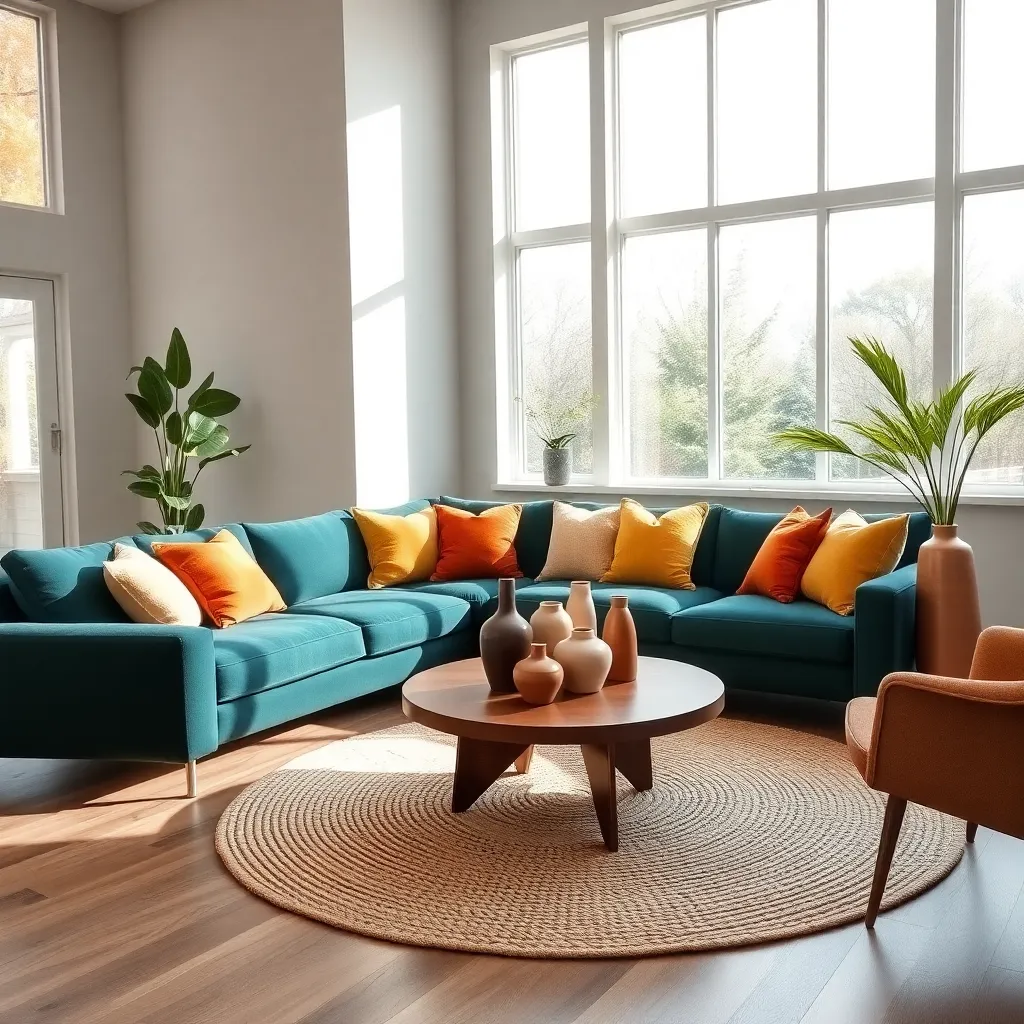
To transform your living room with a touch of elegance, consider introducing textured color elements. Incorporating textures through painted walls or furniture can create depth and interest, making your space feel both modern and inviting.
One way to add texture is by using a variety of materials such as velvet, leather, or woven fabrics. Choose a color palette that complements these materials, like pairing a deep green velvet sofa with warm caramel leather accents.
For a more subtle approach, experiment with textured paint finishes like matte, satin, or even metallics. These finishes can add a sophisticated layer to your walls, enhancing the overall color scheme without overwhelming the space.
Advanced decorators might try layering multiple textures in a single color family for a cohesive look. For example, mix various shades of blue through a plush navy rug, a teal ceramic vase, and sky blue throw pillows to create a unified yet dynamic feel.
Opt for Monochromatic Palettes
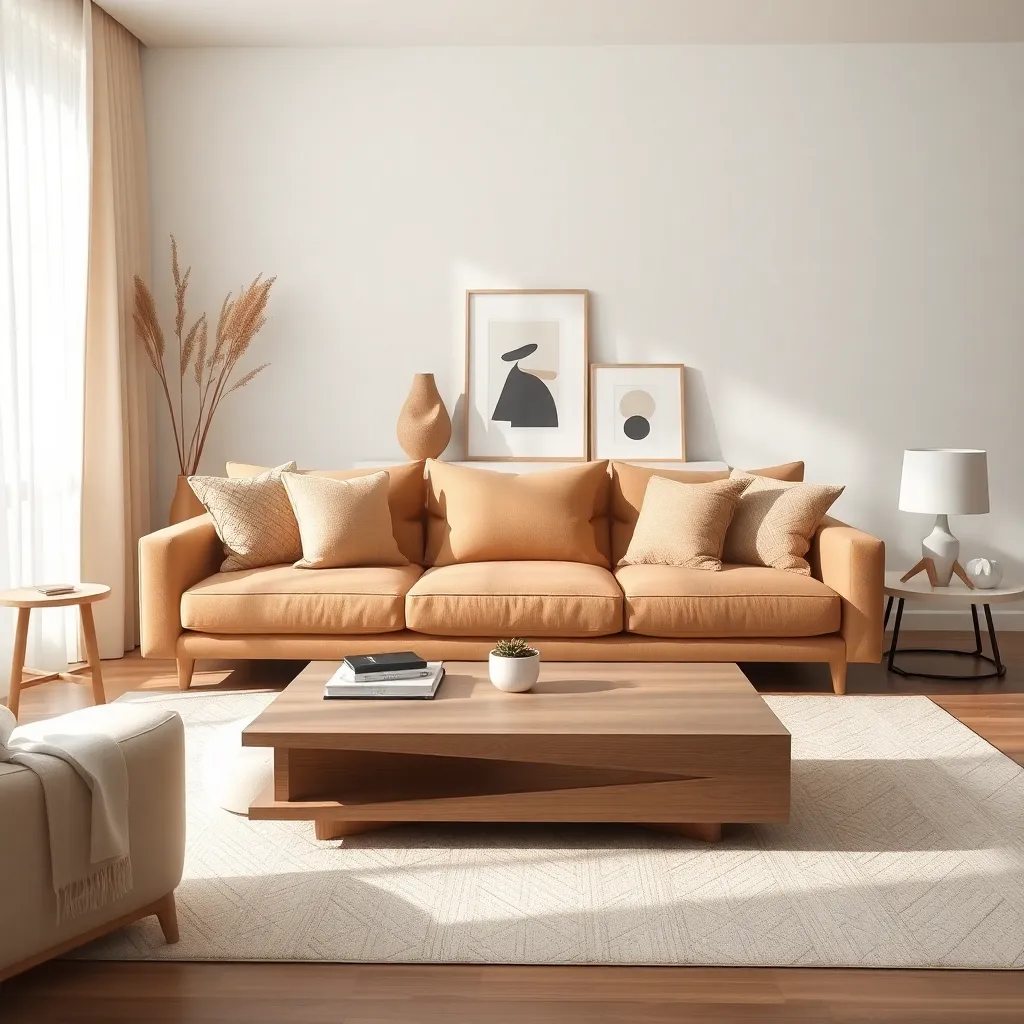
Opting for a monochromatic palette in your living room can create a sense of harmony and sophistication. Begin by choosing a base color that resonates with your personal style—such as a calming shade of blue or a warm tone like beige—and use it as the foundation for your design.
To add depth and interest, incorporate different shades, tints, and tones of your chosen color. For example, if you start with a soft gray, consider adding charcoal throw pillows and a silver rug to the mix. This approach ensures a cohesive look while allowing for variety.
Furniture plays a crucial role in a monochromatic scheme. Opt for pieces that align with your base color but vary in texture, such as a velvet sofa paired with a matte-finish coffee table. This variation in texture adds a layer of visual interest without breaking the color continuity.
For advanced decorators, consider integrating metallic or glass accents to reflect light and add a touch of elegance. A strategically placed chrome lamp or a glass vase can serve as understated yet impactful elements. Remember, the key to a successful monochromatic room is balancing uniformity with subtle diversity.
Mix Pastels with Brights
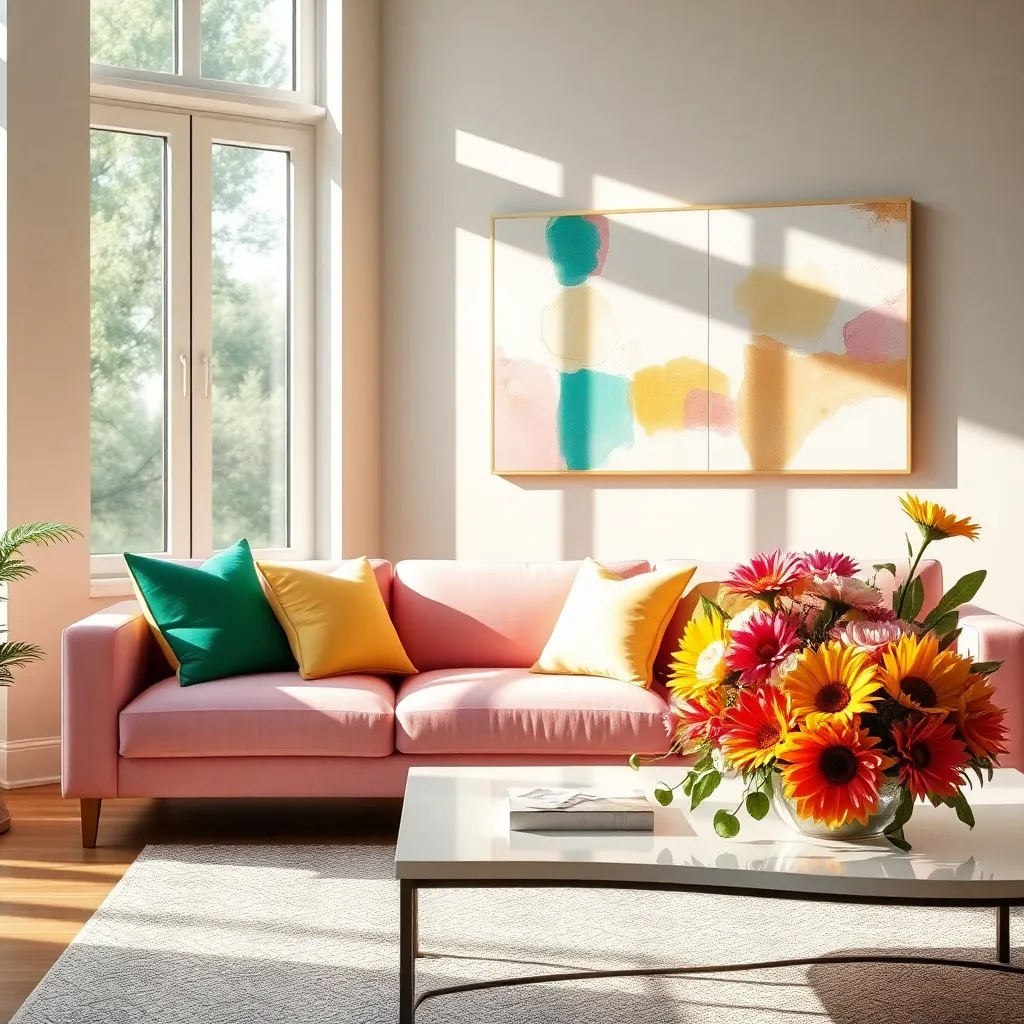
Experimenting with a blend of pastels and brights can bring a fresh and dynamic feel to your modern living room. Consider starting with a soft pastel base, such as a mint green or blush pink, to create a calming atmosphere that serves as a perfect canvas for more vibrant accents.
Introduce bright pops of color through accessories like cushions, throws, or artwork that can be easily updated as trends change. For instance, a bold yellow or electric blue pillow can instantly energize a pastel-colored sofa, adding depth and interest to your space.
Layering textures is another effective method to enhance this color mix, adding visual and tactile interest. Choose a pastel area rug with a subtle texture, and pair it with bright, smooth-finish furniture like a glossy coffee table or a lacquered sideboard to create a balanced contrast.
For those looking to go beyond basic decorating, try using a statement piece of furniture in a bright hue, such as a vibrant orange armchair, to serve as a focal point. Pair this with pastel-colored walls to maintain a harmonious yet lively environment that invites conversation and creativity.
Experiment with Darker Hues
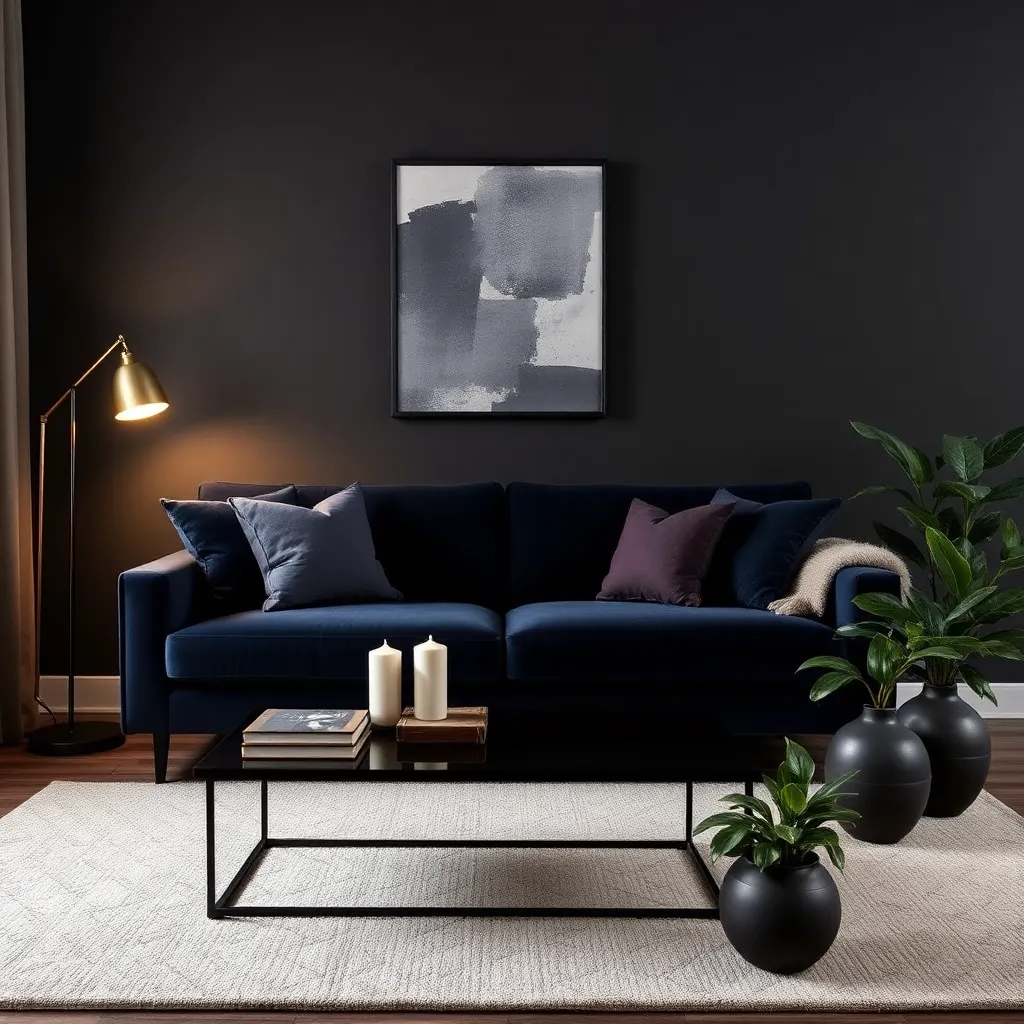
Incorporating darker hues into your living room can create a sophisticated and cozy atmosphere. Begin by selecting a deep, rich color such as navy, charcoal, or forest green as the primary shade for your walls or accent pieces.
To prevent the space from feeling too enclosed, balance these darker tones with lighter elements. Consider using lighter furniture or decor items, like a cream-colored sofa or metallic accents, to provide contrast and visual interest.
One effective technique is to layer textures to add depth and dimension. Use a variety of materials such as velvet cushions, wool throws, and wooden surfaces to enhance the tactile experience in your room.
For those more experienced, experimenting with monochromatic schemes can yield stunning results. Choose varying shades of the same color family for different elements, like a dark accent wall paired with lighter upholstery and mid-tone curtains.
Include Metallic Accents
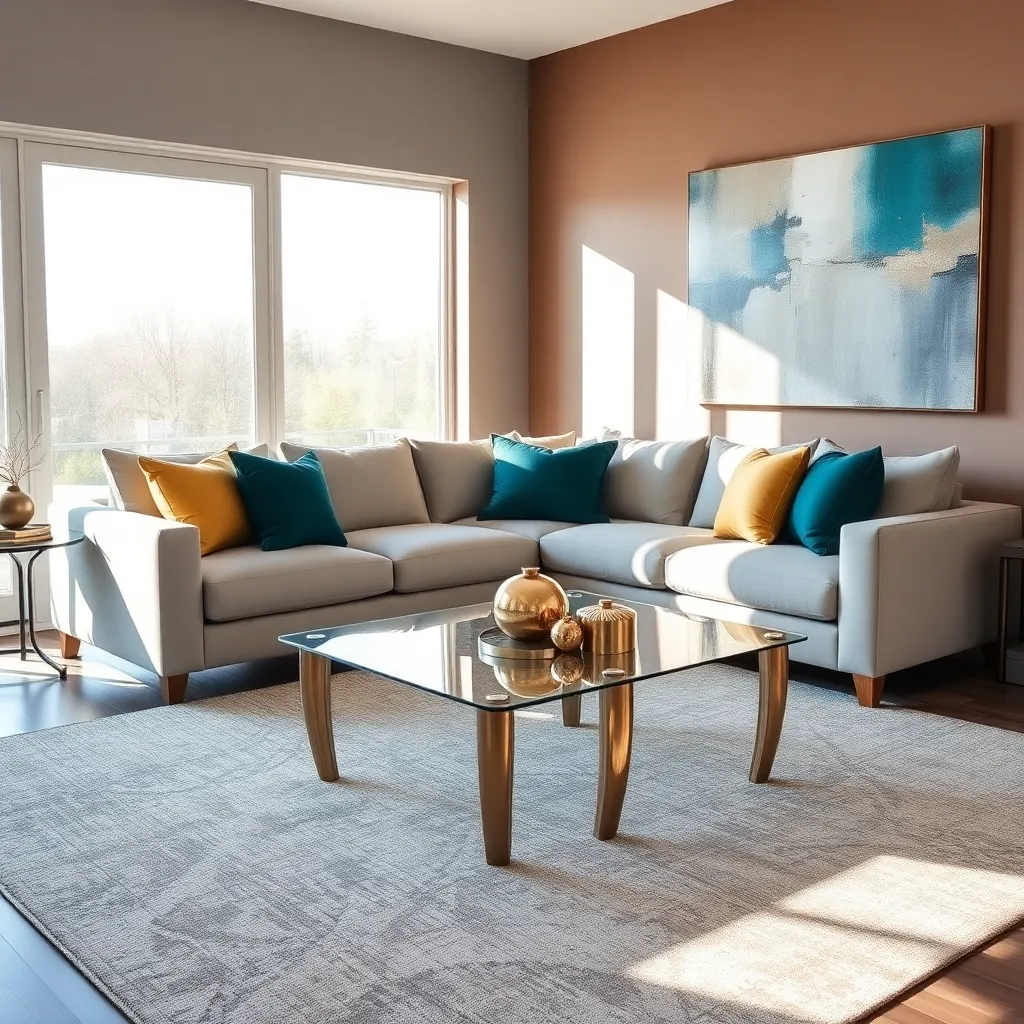
Incorporating metallic accents into your living room can instantly elevate the space, adding sophistication and a touch of luxury. Opt for metallic elements like brass, gold, or silver in the form of table lamps, picture frames, or decorative bowls to create visual interest without overwhelming the room.
For those new to using metallics, start small by introducing a few key pieces that can be easily swapped out or rearranged. Consider placing metallic vases or candle holders on a coffee table or bookshelf to add subtle shine and texture.
Advanced decorators might explore mixing different metallic finishes to create a layered and dynamic look. Pairing cool metals like silver or chrome with warm tones such as gold or brass can create a balanced and harmonious feel when done thoughtfully.
Location and placement play crucial roles in maximizing the impact of metallic accents. Position metallic elements where they can catch light naturally, such as near windows or under spotlights, to enhance their reflective qualities and brighten the room.
Highlight Architectural Features
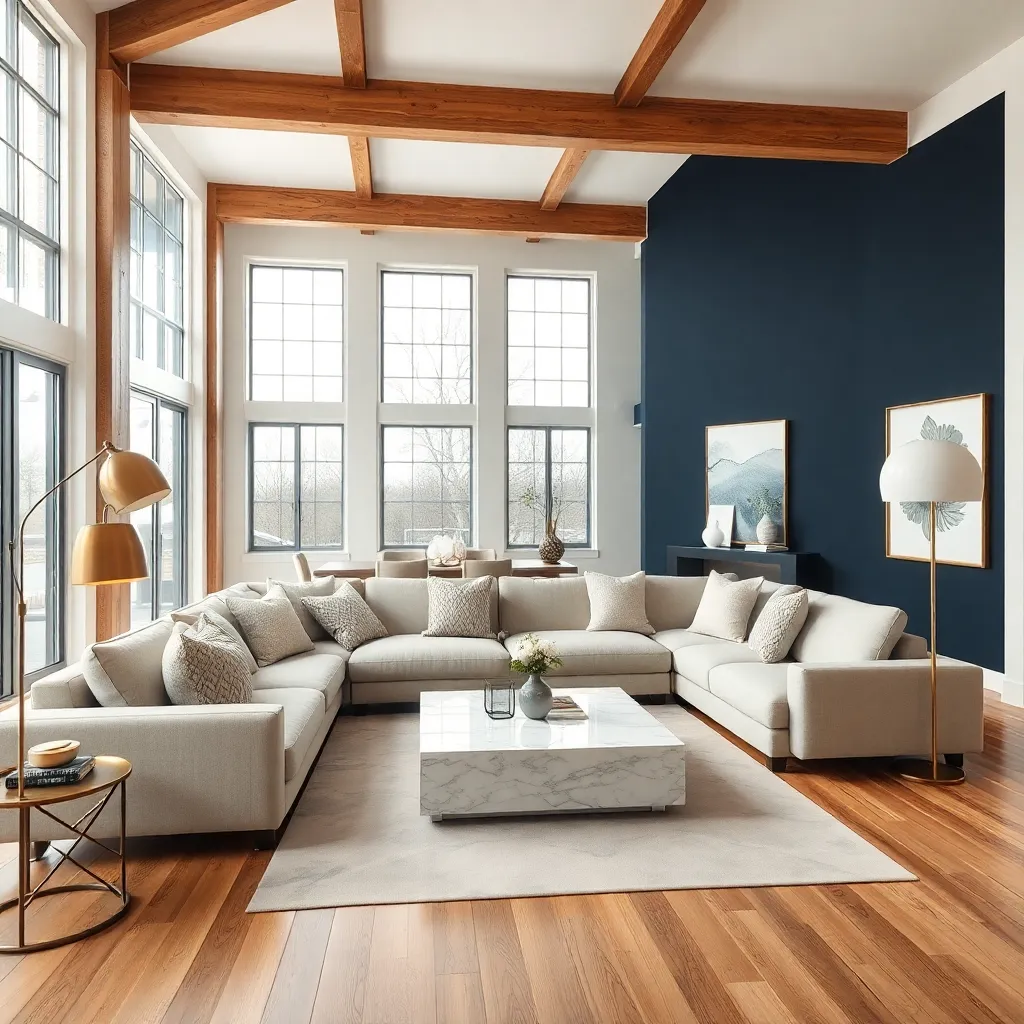
When decorating a modern living room, it’s essential to highlight architectural features like exposed beams, unique ceiling designs, or built-in alcoves. To do this effectively, consider painting these elements in a contrasting color to draw the eye, or use a subtle shade that complements your overall color palette for a more cohesive look.
Incorporating lighting can also enhance these features beautifully. Use accent lighting, such as spotlights or track lights, to illuminate textured walls or detailed moldings, creating dramatic shadows and adding depth to your space.
For those with fireplaces or large windows, these features can become focal points by using color strategically. Paint the surrounding walls a neutral tone to let the natural materials like brick or wood stand out, or use a bold color to frame the feature and create a striking visual impact.
Advanced decorators might consider using color to create an illusion of space or to emphasize height. Employ vertical stripes or a gradient paint effect to make ceilings appear higher, enhancing the room’s architectural grandeur and adding a modern twist to classic design elements.
Rotate Seasonally Appropriate Colors
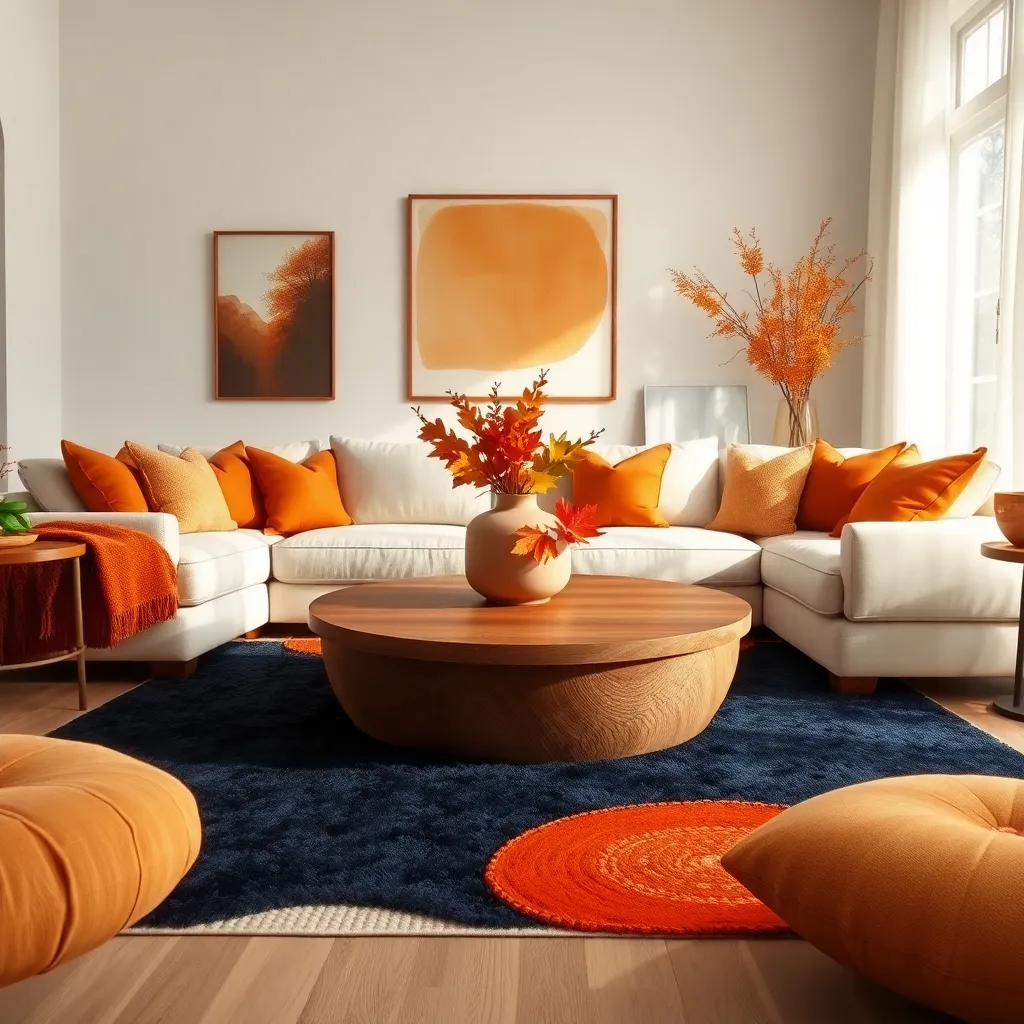
Embracing seasonally appropriate colors is a simple yet transformative way to refresh your living room throughout the year. Begin by choosing a base color palette that remains consistent, then rotate accents like throw pillows, blankets, and artwork to reflect the changing seasons.
In the spring, consider incorporating soft pastels such as lilac and mint green to evoke a sense of renewal. These hues can be beautifully paired with neutral furniture, like a beige sofa, to provide a subtle and sophisticated look.
During summer, opt for vibrant colors like coral and turquoise to bring energy and vitality to your space. Pair these vivid accents with light wood furniture and airy fabrics to enhance the sunlit feel of the room.
For autumn, introduce warm tones such as burnt orange and deep gold through textiles and accessories. A textured rug or velvet cushions in these shades can add depth and coziness, complementing the longer evenings.
As winter approaches, transition to rich, dark colors like deep burgundy and navy to create a snug, inviting atmosphere. Layer these with plush materials like wool or faux fur to add warmth and comfort, perfect for the colder months.
Conclusion: Growing Success with These Plants
In exploring the ’12 Ways To Color Palettes For Modern Living Rooms’, we’ve journeyed through the vibrant spectrum of relationship-enhancing concepts. From embracing authenticity and fostering open communication, to nurturing empathy and cultivating shared experiences, each palette offers a unique hue to enrich your relational landscape. We’ve delved into the importance of trust, the art of compromise, and the celebration of individual growth within partnerships. Additionally, the practice of patience, the power of appreciation, and the joy of shared goals have all painted a vivid picture of thriving relationships.
To take immediate action, choose one concept that resonates with you and apply it in your interactions today—whether it’s initiating a heartfelt conversation or planning a small surprise for your partner. As you embark on this journey to nurture and deepen your connections, make sure to bookmark this article for easy reference, so you can revisit these insights whenever you need a gentle reminder or fresh inspiration.
Remember, the journey to relationship success is a vibrant tapestry woven with intentional actions and heartfelt understanding. By embracing these concepts, you’re setting the stage for a fulfilling and harmonious relationship, one brushstroke at a time. Save this article and return to it as you continue to color your relationship with love and purpose.
